The Benedictine Rules were written by Abbot Benedict of Nursia in the monastery of Montecassino almost 1,500 years ago. There are 73 chapters that determine the life of the monks at the time of the end of late antiquity in great detail. Over the centuries, the work became the authoritative monastic rule throughout the Occident, and most religious orders have followed it to this day. Chapter 40 is often and gladly quoted, which states, among other things: "...every man has his gift of grace from God, some in this way and some in that.... with consideration for the needs of the weak, we think that for each of our community a hemina of wine daily is sufficient." The question naturally arises: How big is a "hemina"? The reliable glossary of Wein-Plus.eu defines: "Hemina = 0.274 litres, ancient Rome, cup quantity." But the measure of the hemina has changed again and again, especially where it is still part of the table tradition, in many monasteries.

|
| Hemina% table wine from Einsiedeln Monastery in Switzerland (Photo: P. Züllig) |
From the range of the Einsiedeln Monastery Winery: "Hemina is a table wine which is composed of several varieties from different origins. A significant proportion comes from our own production from the 'Leutschen', the larger proportion is foreign wine" So wine - probably since the sanction of St Benedict - has been a tradition in many monasteries to this day. Indeed, wherever monasteries were founded in the Middle Ages, viticulture quickly took root. Whether Benedictines, Cistercians, Augustinians, Dominicans, yes, even the Franciscans (mendicant order), they cultivated vines - wherever it was climatically possible. At first, to press Mass wine, but soon they also made wine for daily use, because Benedict, the founding father of the monastic communities, finally allowed wine. In many monasteries, growing vines and pressing wine became one of the most important sources of income. Today, many monasteries can look back on 900 or more years of wine-growing tradition. Many great wineries and wine regions are closely linked to the history of a monastery, both historically and geographically: Eberbach, Pforta, St. Hildegard, Cluny, Fontenay, La Oliva.... The list is endless, much longer than the monasteries that still exist today.

|
| Cistercian monastery Pforta on the Saale% one of the many monasteries dissolved in different centuries (Photo: P. Züllig) |
Wine has also become an important cultural asset through the monasteries and a central value in Christian teaching. The Eucharist (Communion or Lord's Supper) with bread and wine - depending on the doctrine of the faith: a repetition of Jesus' last meal with his disciples, a bloodless visualisation of the sacrifice on the cross or a celebration to commemorate a tradition - became the most important symbol of the Christian message of salvation. Even in France - where the Revolution swept away pretty much all the monasteries - the monastic wine tradition lives on to this day. It is not only carved in stone in museum-like or abandoned monasteries, it is also evident in many vineyards that have long since ceased to be cultivated by monks. Wine stories are also monastery stories, and monastery stories are wine stories. The monasteries were mostly dissolved, but not their vineyards. Eberbach Monastery (Rheingau), for example, was the oldest and most important Cistercian monastery in Germany. As early as the 15th century, it had more than 300 hectares of cultivated land, the largest in Germany. The monastic community has not existed for 200 years; however, 220 hectares of vines still belong to the Eberbach Monastery wine estate, covering a distance of more than 100 kilometres from the Hessian Bergstrasse to Assmannshausen.

|
| Eberbach Monastery in the Rheingau% Germany's largest vineyard even in the Middle Ages (Photo: P. Züllig) |
I became aware of all this - and more - when I sat at table as a guest in the refectory of the Benedictine monastery in Disentis (Switzerland). The monastery is located in the mountains and has no vines or vineyard of its own. There was no Hemina wine on the table either, but rather a bottle with the picture of the former Abbot Pankraz, who was once my class teacher. Homage to the wine or homage to the class teacher? I do not know.

|
| Monastery wine of the Benedictines in Disentis, Switzerland (Photo: P. Züllig) |
The picture of my class teacher and later abbot made me suddenly aware of the comprehensive culture - including a good piece of Christian culture - that lies in the history of wine: The development from a simple agricultural product to a highly paid luxury good, from a simple winegrower to a château owner worth millions, from the monastic hemina to the prestigious wine in a hand-blown glass, from a few vines on a few acres to the huge vineyards on a hundred or more hectares.hectares, from local wine merchants to international online marketing, from monastic viticulture to multi-million dollar auctions. And it is always about the same product - hardly changed in its basic substance - the grape juice that becomes wine. The cultural history of wine - although it has been written for a long time, time and again, in all the centuries up to the present day, it strays into profane pleasure and profit-seeking. Saint Benedict therefore wrote in his rules: "...though we read that wine is not at all suitable for monks, yet because monks today cannot be persuaded of this, we should at least agree not to drink to excess, but less. For wine brings down even the wise."
Sincerely
Yours